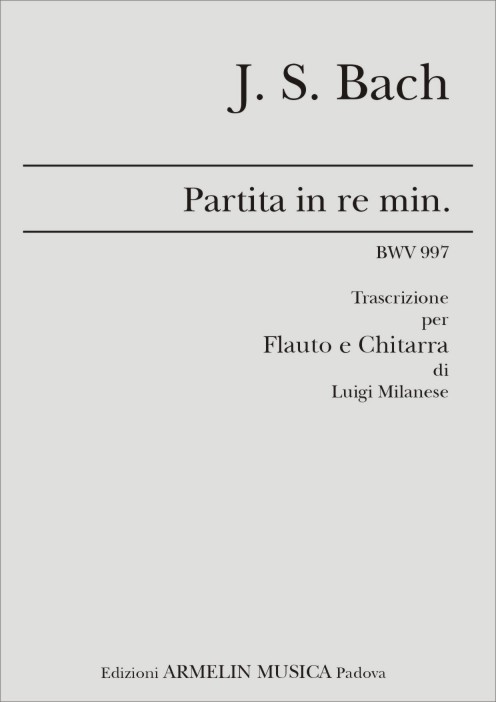Bach, Johann Sebastian
1685-1750
Partita BWV 997
Trascrizione per flauto e chitarra
€22,00
Organico:
PDM 048
9790215810785
21x29,7
20+8
Milanese, Luigi
Armelin Musica
PREFAZIONE
Della Partita BWV 997 esistono l’intavolatura per Liuto (custodita a Lipsia) e i cinque manoscritti custoditi a Berlino. Entrambi derivano sicuramente da un manoscritto originale di J.S. Bach andato perduto. Nell’intavolatura per Liuto mancano la Fuga e il Double, mentre nella versione per clavicembalo troviamo tutte le parti nel loro ordine e nella loro interezza. Probabilmente J.S. Bach ha concepito sul clavicembalo un lavoro originariamente destinato al Liuto: la scarsa alternanza tra i vari registri e la prevalenza del registro superiore su quello grave, utilizzato principalmente come sostegno armonico, sono modalità tipiche dello stile compositivo per Liuto barocco.
Nella presente trascrizione sono stati rigorosamente osservati l’andamento della voce superiore (flauto) e i vari movimenti armonici che la voce inferiore deve compiere come basso continuo (chitarra). In alcuni punti, per realizzare una soddisfacente trascrizione ed un corretto equilibrio fra le varie parti e voci, è stato necessario compiere un arrangiamento. Ciò è stato fatto – credo – mantenendo sempre inalterato il carattere della Partita e le specifiche caratteristiche timbrico-espressive del flauto e della chitarra, sia nei momenti di insieme, sia in quelli individuali
PREFACE
Of the Partita BWV 997 there exist the tablature for Lute (kept in Leipzig) and the five manuscripts kept in Berlin. Both of them derive certainly from an original manuscript by J.S. Bach that has gone lost. In the tablature for Lute the Fuga and the Double have gone missing, while in the harpsichord version we can find all the parts in their proper order and entirety. Probably J.S. Bach conceived a piece of work for harpsichord originally meant for Lute: the scarce alternation of the various registers and the predominance of the superior register on the grave one, mainly used a harmonic support, are typical methods of the compositive style for baroque Lute.
In the present transcription the progression of the highest voice (flute) and the various harmonic movements that the lowest voice has to achieve as a continuo (guitar) have been observed rigorously. In order to realize a satisfactory transcription and a correct balance among the various parts and voices, some passages have been arranged necessarily. This is been made – I believe – always by keeping the peculiarity of the Partita and the specific timbre-expressive characteristics of the flute and the guitar unaltered, both in the ensemble movements and the individual ones.
